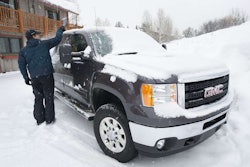Tough 2014 GM Pickups
High-strength steel adds structural strength without increasing weight on built-to-last full-size pickups; aluminum finding its way into other components
Full-size pickups are unique. Their owners routinely use them in ways that would horrify most car owners.
They pull heavy trailers through the mountains, haul tools and supplies down washboard gravel roads, and slog through mud and muck on farms and construction sites.
 And trucks are expected to perform these tasks for years on end, with a minimum of repairs.
And trucks are expected to perform these tasks for years on end, with a minimum of repairs.
To help the new 2014 Silverado measure up to these tasks, engineers chose high-strength steels for the backbone of the new trucks – the fully boxed frames and the structure of the cabs that carry and protect the occupants.
“Chevy owners use their trucks for earning a living and taking care of their families,” said Jeff Luke, executive chief engineer.
“To meet the needs of these hard-working men and women, we chose high-strength steels for the key structural elements of the 2014 Silverado.
That reduces the weight of these components without sacrificing the toughness and durability customers count on.”
To ensure that the new Silverado is up to the challenge, key elements of the updated frame, including the main rails and major cross members, are made from high-strength steel.
Hydroforming is used to improve strength and reduce mass of the front of the frame.
The cab structures are all new, and incorporate high strength steel in the A-pillars, B-pillars, roof rails and rocker panels. Ultra-high-strength steel is used in areas of the rocker panels and underbody in anticipation of new shallow-offset crash tests.
In all, about two-thirds of the cab structure is made from high-strength steels.
Even the pickup bed benefits from tougher steels. The 2014 Silverado 1500 features a roll-formed steel pickup box, which is lighter, stronger and more durable than traditional stamped steel boxes used by major competitors.
Aluminum is used in a number of areas to reduce mass without compromising dependability.
 The blocks and cylinder heads of all three EcoTec3 engines are cast aluminum, while 4WD crew cab models use forged aluminum upper front control arms and cast aluminum lower control arms and steering knuckles for a mass reduction of 42 pounds.
The blocks and cylinder heads of all three EcoTec3 engines are cast aluminum, while 4WD crew cab models use forged aluminum upper front control arms and cast aluminum lower control arms and steering knuckles for a mass reduction of 42 pounds.
The hoods are also aluminum, saving 17 pounds over a comparable steel panel.
The strategic use of high strength steels, aluminum and other premium materials enabled engineers to create a new Silverado that is stronger, more capable and more efficient than current models, while still being lighter than comparable models from a key competitor.
The materials and technologies used for Chevrolet pickups will continue to evolve, as truck customers face fluctuating fuel prices and truck makers engineer for strict new federal fuel economy standards, said Luke.
“But whether we are engineering full-size pickups like Silverado, or our efficient new midsize trucks, we can’t forget that trucks are workhorses.
The materials we select and the powertrains we engineer must be able to get the job done, and save our customers money by holding down overall cost of ownership year in and year out.”
To help validate its design and materials for the 2014 Silverado, GM’s new full-size trucks will undergo more than 6 million miles of durability testing on proving grounds and tough test roads, equivalent to 240 trips around the earth. In addition, the trucks will accumulate real-world mileage in excess of 7 million miles during final testing, bringing total test miles to more than 13 million.
Founded in 1911 in Detroit, Chevrolet is now one of the world’s largest car brands, doing business in more than 140 countries and selling more than 4 million cars and trucks a year. Chevrolet provides customers with fuel-efficient vehicles that feature spirited performance, expressive design, and high quality. More information on Chevrolet models can be found at www.chevrolet.com.








